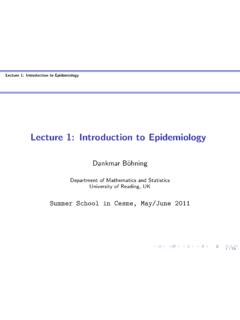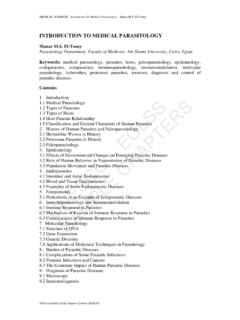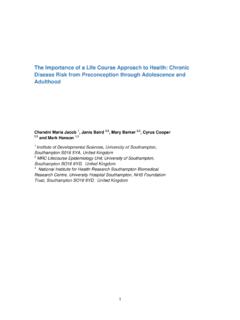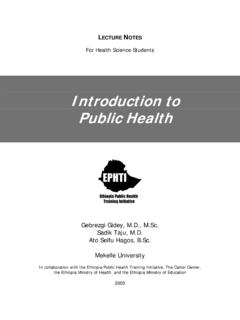Transcription of Introduction to Epidemiology (Lecture notes)
1 Introduction to Epidemiology (Lecture notes) Adebimpe Olalekan MBBS, MPH, FWACP, PhD, FRSPH, MNIM Contents Concept of Health and Disease Infectious disease Epidemiology Disease prevention and control Disease screening Epidemics investigation NB: This is a summary note to compliment your reading. It does not in any way replace your lectures, class notes, textbooks or other learning materials. Concept of Health and Disease Definition of Health WHO defined health as a complete state of physical, mental and social well being and not just the absence of disease or infirmity, leading to an ability to lead a socially and economically productive life Health cannot be a state. It should be dynamic?
2 A continuum- which changes as indices of life changes Health cannot be measured by this definition The concept appear broad, and relegated the environment Concept of Health Biomedical concept: based on absence of disease. However the importance off the environment is relegated Ecological concept: based on dynamic equilibrium between man and his environment. However, a perfect man or perfect environment rarely exists Psychosocial concept: Man s socioeconomic indices determines his health including what he can afford or access, his politics, culture etc Holistic concept: combines all above Determinants of health Health in the middle Individual, family and communities surrounding Health The various determinants surrounding: Biological/genetic Social Cultural Economic Access to health services Gender Environmental Genetic Nutritional etc Concept of well being How well you are incorporates 2 components (1) Objective concept= standard of living: your expenditure, income, occupation etc (2) Subject component.
3 Quality of life=condition of life resulting from the combination of effects of factors that determines your health, or how individual, or group perceive their physical, mental and social well being Physical Quality of Life Index (PQLI): consolidates 3 indicators- literacy rate, life expectancy at one, and IMR Human Development Index: longevity Spectrum of health Evidence to show that health is not static Positive side Positive health Better health Freedom from sicknesses Negative side Unrecognized illnesses Mild sickness Moderate sicknesses Severe sicknesses Death Indicators for health How healthy is a community? Needs measurements Indicators are thus required Qualities of indicators: valid, reliable, sensitive, specific, feasible and relevant Types of indicators: mortality, morbidity, disability, nutritional, health care delivery, Health utilization, environmental, socioeconomic, health policies, indicatprs of quality of life, etc Assignment: Give 3 examples each of these indicators Categories and list 10 indicators used to monitor progress towards Health For All(HFA) Elaborate the provisions of MDGs Vs.
4 SDGs Ecology and dimensions of health Ecology Mans total environment Biological: living things- man and animals Physical: Non living things Psycho-social: customs, laws, religion etc As man alters his environment, he creates more problems for himself informed by inter-relations among the different components Dimensions of health: Physical Mental Spiritual Emotional Vocational Social Concepts of disease all not the same Theory of Disease causation Supernatural theory: sin against God Spontanous generation Humors Miasma Germ: agent=sole cause of disease Epidemiological triad: agent, host and environment Multi-factorial causation Disease is due to multiple factors contrary to the idea of germ theory Applied more to NCDs-risk factors Web of causation: use MI as example Iceberg phenomenon of disease Many cases of illnesses not recognized, not reported and therefore remain hidden Many cases Self treatment Treatment by traditional healers Treatment by quacks Only few cases(the tip of the icebergs) got reported This necessitates screening, case finding, contact tracking and other epidemiological approach INFECTIOUS DISEASE Epidemiology Definition of terms Assignment.
5 Define and elaborate on the following terms Infectious disease Contagious disease Epidemic: in excess of expected occurrence Endemic: constant presence within a geographical region Sporadic: scattered, irregular, few cases, haphazardly, from time to time Pandemic: epidemic now spread worldwide HIV Exotic: disease imported into a country in which they do not otherwise occur rabies in UK Zoonoses: diseases of animals transmitted to man Anthropozoonosis; if from vertebrate animals to man rabbles, plague Zoonoanthroposis from man to vertebrate animal Human TB in cattle Both direction: T. cruizi infection Epizootic=epidemic of disease in an animal population & may eventually affect man rabies, anthrax and brucellosis Definition of terms Enzootic: endemic occurring in animals: anthrax, rabbles, brucellosis, bovine TB Nosocomial: hospital acquired infections Iatrogenic or Physicians induced or causing it Opportunistic infections Case: could be subclinical cases, latent phase in which host does not shed the infective agent which lies dormant within the host without symptoms.
6 All these are potential sources of infection Primary case=1st Case of a disease Index case-1st case that comes to physician attention, Secondary case= cases propagating from primary case Suspect is someone who have all the signs and symptoms but not yet diagnosed Epidemiological triad Epidemiological triad : based on the model of Agent Host Environment Time Agent: is the cause of disease- viral, bacterial, fungal etc etc With regards to NCDs: agent could be a chemical (from dietary food, tobacco smoke, solvents), radiation, nutritional deficiency etc Host: is an organism usually human or animal that harbors' the disease Environment: surrounding where disease thrives: Physical, Biological and Psychosocial Time: incubation period, duration of illness, life expectancy of the host or pathogen, severity of illness Agents Agent: should be able to multiple, emerge from the host, reach and infect a new host.
7 Agents lives and multiple in the reservoir from where it is transmitted to other habitat. Common types include Biological or infectious agent: Characteristics include Pathogenicity Infectivity Virulence Nutrient agents: deficiency of any of the components of food leading to PEM etc Physical agents : health cold, humidity, pressure Chemical: endogenous ( urea, bilirubin etc) or exogenous ( allergens, metals and dusts)to the host Social agents: poverty, alcohol, smoking, drug abuse etc Reservoir Reservoir or source of infection It is the ecological niche (person, animal , arthropod, soil etc) in which an infectious agent lives and multiplies and on which it depends primarily for survival and where it reproduces itself in such a manner that it can be transmitted to a susceptible host Source= person, animal or object from which an infectious agent passes or is disseminated to the host.
8 It may or may not be a part of the reservoir Animal reservoir: Zoonoses: examples: taeniasis, plague, rabies, Non living things reservoir: majority are saprophytes living in soil as r tetanus and anthrax Reservoir Hookworm = Reservoir (man) and the source (soil contaminated with infective larva) Tetanus: Reservoir and source are the same (soil) Typhoid: reservoir is the case or carrier, Source is the faeces or urine of patients or contaminated food, drinks or Reservoir can be a living (man or animal) or non living thing Man as reservoir, Carriers CARRIERS Due to inadequate treatment or immune response, the infectious agent might not be completely eliminated, leading to development of a carrier state.
9 A Carriers is an infected person or animal which harbors the infective microorganism , but shown no signs or symptoms but have the capability of transmitting the disease from one person to the other. They are less infective, but more dangerous as they can infect large people over a wide area. Example=typhoid Mary They shed the infective agent in the discharge of excretion or discharges, and acting as source of infection for other patient. Carriers may outnumber the cases, Carriers Types of carriers incubatory(measles, mumps, polio, pertusis, diphtheria, Hepatitis B) convalescents(typhoid, dysentery, cholera Healthy (victim of subclinical disease acting as a carrier) - polio, cholera, meningitis, salmonella, diphtheria).
10 They are not sick so can easily infect others without taking caution Duration: Temporary carriers ( ICH), Chronic(typhoid, hepatitis B, CSM, malaria, gonorrhea. They do introduec infection to free areas, so should be controlled early Portal of exit of the infections agent: urinary, intestinal, respiratory Host/environment Host creates lodging or subsistence for the agent Host factors include: Demographic: age, sex, race Biological such as genetic make up, blood groups, Socioeconomic factors; education, occupation, housing Lifestyle factors: personality traits, living habit, exercise etc Others: level of immunity, overall fitness, state of health In NCDs: we talk about risk factors, not the agent: It is an attribute or exposure that is significantly associate with development of a disease Assignment: List the common risk factors associated with common NCDs in Nigeria Environment.)





